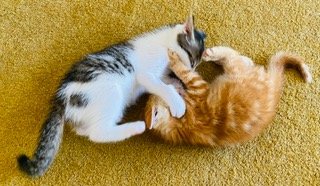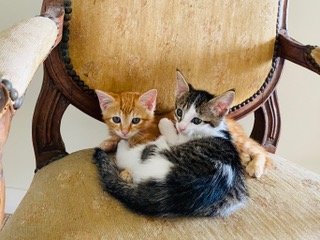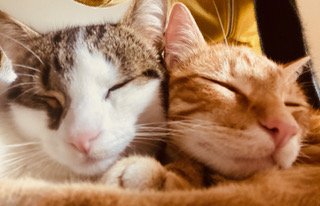KITTENS ON THE BRAIN
Late one afternoon, I heard loud, insistent miaowing. Our fat ginger puss Harvey had died two years earlier, and our property was now Grand Central Station for the local cat population. But they only came out at night, and the sun was still in the sky.
I followed the demanding cries to the huge compost heap under the tall flame tree—no sign of a cat. I bent down and peered into the heap, and there amongst the tangle of branches and endless weeds was a tiny kitten. Its eyes were piercing blue, so I knew it must be under seven weeks old. Where was its mum, I wondered, and siblings?
As I approached, the kitten retreated into the impenetrable foliage, but the moment I turned to walk away, the piercing cries started up again. "Food now!" was the obvious message.
I had some wet cat food in the cupboard for hedgehog emergencies and plopped a couple of teaspoons-full out on a plastic lid. The kitten waited till I retreated a safe distance before hauling itself out of the compost heap and gobbling every morsel in a trice.
For the next week, desperate yowls greeted me morning and night, and I obediently delivered food for the kitten, then crouched behind a bush to watch it eat. It was tiny. Mostly white but with splashes of tabby over its back and a couple of splotches on its haunches. The tabby colouring extended over one eye, giving it a rakish look. Picasso could have painted it.
It was a plucky little thing. Some afternoons I found it a few yards from the heap, taking in the local sights and sounds, and its call seemed designed for a much bigger animal. I had started talking to the kitten, sometimes singing to it, and it was beginning to realise I was more of a meal ticket than a threat.
About 9 pm one night, the familiar cries cut through the hum of ever-present traffic outside our gate. The sound seemed closer than usual, and though I had never fed it at night before, I headed out into the darkness and put a small plate of food by the heap. When I returned 10 minutes later, the food was untouched, but the minute I returned to the kitchen, the cries sounded again. This pattern was repeated three more times. Cat calls, food delivered, no response. It was pitch black outside, so I took a torch the fourth time and followed my hunch that the kitten was closer than usual. And there it was, right outside the window under a fern. The tiny little thing had ventured about 50 metres from its safe spot over open ground. I was full of admiration.
The next day I picked up a cat-catching cage and a dog crate from an animal-obsessed friend. She told me how to set up the cage to lure the kitten inside. Within minutes I heard the crash of the gate being triggered. I took the kitten inside the house and transferred it to the dog crate, where it made itself at home in a small cardboard box furnished with a rumpled towel.
I looked at the kitten. "Gregory", I thought and told my Indian friend the puss's new name. She had never heard the name Gregory and thought I was saying Jaggery (an unrefined form of sugar). Well, his markings were certainly jagged. And he did seem sweet. So Jaggery it was.
The following week I discovered three more kittens and a tortoiseshell-coloured mother cat living under what we called The Rat Shed. The kittens seemed about the same age as Jaggery from the look of their bright blue eyes, and I knew they'd face a hard life as ferals, so out came the cat-catching cage again. The first night I caught two, a black short-hair and a long-haired tabby. The black one looked used to taking the lion's share of food. And the tiny tabby was its little sidekick, out for any remaining crumbs. I gave these two to '9 Lives', who take in unwanted kittens and domesticate them so they will be suitable for adoption. Apparently, there was a bumper crop of feral kittens this season.
I had my eye on the remaining kitten, a small ginger. I've always loved ginger cats, and this one looked like the runt of the litter. It was very timid but returned my gaze and gave a slow blink, so I knew we had a rapport. It took ages for the shy little thing to venture into the cage for food. But when hunger finally overtook fear, it cautiously ventured into the cage and SLAM. There was no going back.
For the next couple of weeks, I put food out for the mother cat to get her spayed. These days the advice is to neuter females and release them back into their familiar territory. But Mrs Cat was too smart to be caught. She was young and healthy, and I knew that as soon as her kittens were weaned, she'd be fertile again, and the tom cats would come prowling.
While Jaggery was a larger-than-life entertainer, the little ginger puss was withdrawn. He looked sad and solemn, so I called him Solomon. Solly for short. The two kittens became best friends. They were brothers, after all. They played together and slept curled up together, and Solly slowly started coming out of his shell. He missed his mum for the first two weeks, and she missed him, her sweet little golden boy. She came every night to check he was being looked after. But once she saw he was in good hands, she disappeared.
Jaggery and Solly are now spoilt little princes, and the house definitely looks worse for wear since they arrived. Plants, curtains and rugs shudder when they approach. While they are great company and love to be close (especially after eating), I never forget that they are wild animals, adept with tooth and claw. The hunting tally thus far is one grand daddy rat, two skinks and three pieces of toast.
The new fleaBITE song, KITTENS ON THE BRAIN, is dedicated to these two and '9 Lives' who foster kittens. Get em…and get them neutered. New Zealand doesn't need any more feral cats!
KITTENS ON THE BRAIN - find the single now





